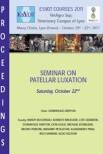BACKGROUND: Double pelvic osteotomy (DPO) planning is usually performed by hip palpation, and on radiographic images which give a poor representation of the complex three-dimensional manoeuvre required during surgery. Furthermore, bone strains which play a crucial role cannot be foreseen.
OBJECTIVE: To support surgeons and designers with biomechanical guidelines through a virtual model that would provide bone stress and strain, required moments, and three-dimensional measurements.
METHODS: A multibody numerical model for kinematic analyses has been coupled to a finite element model for stress/strain analysis on deformable bodies. The model was parametrized by the fixation plate angle, the iliac osteotomy angle, and the plate offset in ventro-dorsal direction. Model outputs were: acetabular ventro-version (VV) and lateralization (L), Norberg (NA) and dorsal acetabular rim (DAR) angles, the percentage of acetabular coverage (PC), the peak bone stress, and moments required to deform the pelvis.
RESULTS: Over 150 combinations of cited parameters and their respective outcome were analysed. Curves reporting NA and PC versus VV were traced for the given patient. The optimal VV range in relation to NA and PC limits was established. The 25° DPO plate results were the most similar to 20° TPO. The output L grew for positive iliac osteotomy inclinations. The 15° DPO plate was critical in relation to DAR, while very large VV could lead to bone failure.
CLINICAL SIGNIFICANCE: Structural models can be a support to the study and optimization of DPO as they allow for foreseeing geometrical and structural outcomes of surgical choices.
A structural numerical model for the optimization of double pelvic osteotomy in the early treatment of canine hip dysplasia
Journal
Zanetti EM, Terzini M, Mossa L, Bignardi C, Costa P, Audenino AL, Vezzoni A.. Vet Comp Orthop Traumatol. 2017 Jul 20; 30(4): 256-264.









